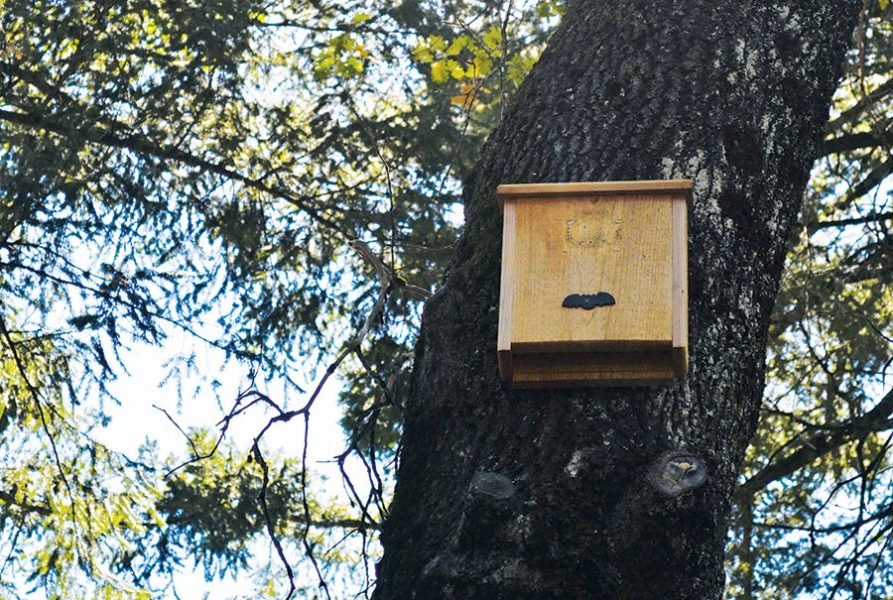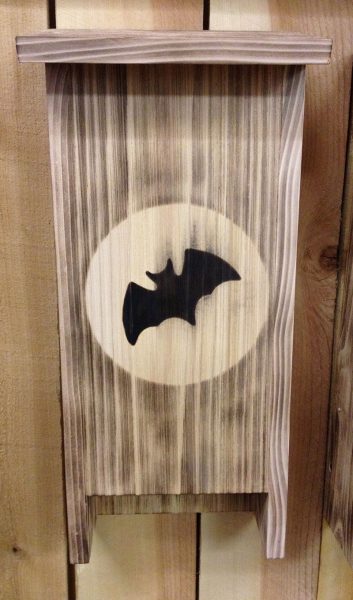What hangs upside down, loves mosquitoes and sleeps all day?
A bat, of course!
Bats have been both revered and feared, by ancient and modern folk alike. They have carried the heavy stigma of disease-ridden, blood-sucking varmints whose favorite sport is to get snared in some unwitting person’s hair.
Bats are often thought of as creatures of the night, possessing some sinister dark art and living a shadowy existence among the ruins of a haunted castle shared by demons and ghouls.
Since humans are often afraid of what they don’t understand, and can’t see in the dark, it’s no wonder bats get a bad rap.
Hopefully, this article will help shed some light on the shadowy, and very misunderstood, existence of bats. Let’s debunk a few myths:
Myth 1. Bats have bad eyesight.
Bats in fact have better eyesight than humans but they also use echolocation to find their food. Far from wanting to land in your hair, bats excel at aerial maneuverability, making every attempt to successfully avoid hair, trees, houses and predators. They do this through an evolutionary adaptation, known as echolocation.
In a nutshell, bats emit high-frequency sound waves that bounce back off their surroundings, including insects. As the waves return to their finely-tuned ears, they paint a picture of the bat’s environment, much like we use the light from a flashlight to bounce off objects and back to our eyes. Bats do this with such precision that even a mosquito’s body stands out like a neon sign. Imagine spotting a single mosquito, at night and with a flashlight, flying 10 feet away.
Myth 2. Bats are “flying mice.”
The fact is, bats are not related to rodents. They are in a group of their own called “chiropera,” which means “hand-wing.” Bats are actually grouped with and share a closer ancestry with primates and lemurs. Bats are extremely unique in that they are the only real flying mammal! Unlike rodents, bats can only produce one to two pups (offspring) each year.
Myth 3. Bats carry diseases and are dirty.
Bats have the ability to carry rabies, but less so than raccoons and skunks; less than half of one percent of wild bats are actually infected. Bee stings are more dangerous to people! Best advice: never touch a bat or wild animal. If you see them active during daytime or on the ground, it’s best to leave them alone. As for cleanliness, bats are constantly grooming themselves.
Myth 4. All bats suck blood.
Of the 1,100 bat species throughout the world, only 3 are vampire bats, limited mostly to Latin America. Many bats are vegetarians; their diet consists solely of fruit. Most species are insect-eaters, often considered “farmer’s best friend” because they eat damaging agricultural pests. A recent study found that bats save farmers $1 billion in crop damage around the world!
Bats are also important pollinators in parts of the world, supporting local economies. A single brown bat can catch more than 1,200 mosquito-sized insects in one hour! Some bats can even consume their weight in insects per night. Bats are very important and vital to the health of ecosystems.
And let’s not forget about the amazing and beneficial “guano” that bats produce, used in the gardening industry. That’s right, bat poop! Guano works as a great fertilizer for growing healthy plants.
Sadly enough, half the bats in the U.S. are listed as rare, threatened or endangered.
Bat populations are in rapid decline due to factors such as habitat destruction, pesticide poisoning, deliberate eradication attempts, a decrease in foraging habitat due to urban development, and a crippling fungus known as white nose syndrome (WNS). WNS infects bats while they are hibernating, causing them to develop distinctive white growths on muzzle, body and wings. The disease has so far killed millions of bats in a span of less than 10 years.
In Northern California we have about 17 species of bats, a handful of which will use a man-made box to roost in during spring and summer months. Learn to cherish these unique flying mammals in your yard by making it a bat-friendly habitat.
 All Bat Houses Are Not Created Equal
All Bat Houses Are Not Created Equal
Encourage Bats as your friendly low-cost, eco-friendly mosquito control team! Bats are easy to host and inexpensive to feed. Whether you are looking for or want to build a bat house, keep these handy tips in mind:
An effective bat house should:
- Be at least 2-feet tall
- Have chambers at least 20” tall and 14” wide
- Have a crevice width of 3/4” – 1 1/2” (3/4” discourages use by wasps)
- Have ventilation in the lower 3/4 of the box
- Have a decent size landing (at least 3”- 6”)
- Be made from wood or plywood able to withstand the elements (the top should not leak)
- Wood surface needs to be rough or covered with durable mesh (lining the box with fiberglass window screen is ideal)
To increase your chance of bat occupation:
Place your bat box in an area that will receive at least seven hours of morning sunlight, preferably on a building, tall post or pole (trees usually provide too much shade).
Preferably place your bat box close to water – a stream, pond, meadow or moist field.
To maintain your box:
Stain the outside a dark color if your area’s average high temperatures in July are less than 85 degrees, medium colors where they are 95-100 degrees, and use white or light colors where temperatures exceed 100 degrees. Do not paint the interior.
Inspect the box annually for wasps.
Fall is the best time to install a box, so it can wear off the “new” feel and become a bit more weathered before occupation. To quicken the chances of occupation, the best thing to do is fill the inside with dirt, let sit for a day or two, then dump it out before installing. This will give it a good “earthy” start.
Install at a minimum of 10 feet high in a location safe from predators and curious by-standers that might want to disturb the box to see the bats fly out.
Oct 24-31 is Bat Week
Bat week is an international celebration of the role bats play in nature. Organized by a team of representatives from multiple conservation organizations, the annual week-long campaign aims to educate the public on bats. Last year, the event helped set a new Guinness World Record for the most bat houses built in a day: 1341! This year’s focus is a “Bat Pull” event where everyone’s invited to host an invasive plant pull to help improve habitat and food for bats and other wildlife. Keep your “weed warriors” engaged this fall while helping out bats. Find out more at http://www.batweek.org.
Local Bat Events
Friday, October 28: Build a Bat House Workshop & Bat Talk, Mt. Shasta. Kendra Bainbridge and friends lead the way during this fun and informative event for all hammer-swinging ages! Parent supervision required for youngsters. Starts 5pm. $10; includes materials. Location TBA. Call or stop by Raven Tree to reserve your spot, 138 Morgan Way (Ray’s Shopping Center). (530) 926-6695.
Friday, Oct 28: Camp Chico Creek transforms into Camp Chico Creepy for a parent’s night out educational evening program for kids. Your child will experience the “creepy” wonders of Bidwell Park in a fun, safe environment while learning about bats, owls, spiders and other “creepy” things in nature. Includes pizza and a night hike to look for owls (and bats). Open drop-off & pick-up between 5-10pm. $30. Chico Creek Nature Center, 1968 E 8th St.
Learn More About Bats by Visiting
- http://www.batcon.org
- http://www.batworld.com
- http://www.nrcs.usda.gov (search “bats”)
Bat-Themed Books To Read To Your Children
- Bat Loves the Night by Nicola Davies and Sarah Fox-Davies
- Stellaluna by Janell Cannon.
A tip for parents and teachers: You can find an abundance of fun and informative children’s activities related to these books online.
Comment Policy: All viewpoints are welcome, but comments should remain relevant. Personal attacks, profanity, and aggressive behavior are not allowed. No spam, advertising, or promoting of products/services. Please, only use your real name and limit the amount of links submitted in your comment.







